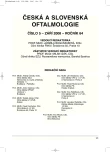-
Medical journals
- Career
Posterior Capsule Opacification in Patients with Type 2 Diabetes Mellitus
Authors: J. Nekolová; J. Pozlerová; N. Jirásková; P. Rozsíval
Authors‘ workplace: Oční klinika LF UK a FN, Hradec Králové, přednosta prof. MUDr. Pavel Rozsíval, CSc.
Published in: Čes. a slov. Oftal., 64, 2008, No. 5, p. 193-196
Overview
Purpose:
To compare the degree of posterior capsule opacification (PCO) after cataract surgery in patients with type 2 diabetes mellitus (DM) and in nondiabetic patients.Patients and methods:
All surgeries were done at Department of Ophthalmology, University Hospital in Hradec Králové and three-piece Alcon AcrySof intraocular lens (MA60BM or MA30BA) was implanted in all eyes. Seven years after surgery, examination of eyes was done including best corrected Snellen visual acuity (BCVA) measurement. Digital retroillumination photographs of mydriatic anterior segments were taken and PCO was assessed using EPCO 2000 software for PCO quantification. Patients enrolled in the study were devided into two groups – with type 2 DM and without DM. EPCO index for 4 PCO severity grades and Total EPCO index for entire IOL were compared between the groups. The incidence of Nd: YAG laser capsulotomy and operative Elschnigg pearls removal, as well as BCVA, were also evaluated. Statistical analysis was performed using nonparametric tests.Results:
82 patients (140 eyes) were analyzed. 26 of them (36 eyes) were type 2 diabetics (DM group), none type 1 diabetics, remaining 56 nondiabetic patients (104 eyes) were enrolled in the control group. Total EPCO index for the DM group was 0.531 ± 0.543, for the control group 0.492 ± 0.532, no significant difference (P = 0.66). No significant different in Nd: YAG capsulotomy rate (22.2 % for DM vs. 17.3 % for control, P = 0.62) and operative Elschnigg pearls removal (8.3 % for DM vs. 1.9 % for control, P = 0.11) was proved. BCVA in the DM group was 0.80 ± 0.29, in the control group 0.82 ± 0.22, no significant difference (P = 0.78).Conclusion:
No significant difference in PCO extent, Nd: YAG capsulotomy rate and operative PCO treatment was proved between the patients with type 2 DM and the control group. However, all outcomes were nonsignificantly worse in the diabetic patients.Key words:
posterior capsule opacification, three-piece AcrySof IOL, type 2 diabetes mellitus
Sources
1. Péče o nemocné s cukrovkou 2006. Zdravotnická statistika. Ústav zdravotnických informací a statistiky ČR, Praha 2006.
2. Dowler, J.G.F., Hykin, P.G., Lightman, S.L., et al.: Visual acuity following extracapsular cataract extraction in diabetes: a meta analysis. Eye, 9, 1995 : 313-317.
3. Ebihara, Y., Kato, S., Oshika, T., et al.: Posterior capsule opacification after cataract surgery in patients with diabetes mellitus. J Cataract Refract Surg, 32, 2006; 7 : 1184-1187.
4. Hancox, J., Spalton, D., Heatley, C. et al.: Fellow-eye comparison of posterior capsule opacification rates after implantation of 1CU accommodating and AcrySof MA 30 monofocal intraocular lenses. J Cataract Refract Surg, 33, 2007; 3 : 413-417.
5. Hayashi, K., Hayashi, H., Nakao, F., et al.: Posterior capsule opacification after cataract surgery in patients with diabetes mellitus. Am J Ophthalmol, 134, 2002; 1 : 10-16.
6. Hayashi, H., Hayashi, K., Nakao, F., et al.: Quantitative Comparison of Posterior Capsule Opacification After Polymethylmethacrylate, Silicone, and Soft Acrylic Intraocular Lens Implantation. , 116, 1998; 12 : 1579-1582.
7. Chew, E.Y., Benson, W.E., Remaley, N.A. et al.: Results after lens extraction in patients with diabetic retinopathy: Early Treatment Diabetic Retinopathy Study report number 25. Arch Ophthalmol, 117, 1999; 12 : 1600-1606.
8. Ionides, A., Dowler, J.G.F., Rosen, P.H., et al.: Posterior capsule opacification following diabetic extracapsular cataract extraction. Eye, 8, 1994 : 535-537.
9. Kohnen, S., Ferrer, A., Brauweiler, P.: Visual function in pseudophakic eyes with poly(methyl methacrylate), silicone, and acrylic intraocular lenses. , 22, 1996; Suppl 2 : 1303-1307.
10. Mian, S.I., Fahim, K., Marcovitch, A., et al.: Nd: YAG capsulotomy rates after use of the AcrySof acrylic three piece and one piece intraocular lenses. Br J Ophthalmol, 89, 2005; 11 : 1453-1457.
11. Nishi, O., Nishi, K., Fujiwara,T., et al.: Effects of the cytokines on the proliferation of and collagen synthesis by human cataract lens epithelial cells. Br J Ophthalmol, 80, 1996; 1 : 63-68.
12. Pandey, S.K., Apple, D.J., Werner, L., et al.: Posterior Capsule Opacification: A Review of the Aetiopathogenesis, Experimental and Clinical Studies and Factors for Prevention. , 52, 2004; 2 : 99-112.
13. Tetz, M.R., Auffarth, G.U., Sperker, M., et al.: Photographic image analysis system of posterior capsule opacification. J Cataract Refract Surg, 23, 1997; 10 : 1515-1520.
14. Ursell, P.G., Spalton, D.J., Pande, M.V. et al.: Relationship between intraocular lens biomaterials and posterior capsule opacification. J Cataract Refract Surg, 24, 1998; 3 : 352-360.
15. Valešová, L., Hycl, J.: Operace katarakty u diabetiků. In Valešová L, Hycl J. Diabetická retinopatie. 1.vyd. Triton, Praha 2002, 146 s.
Labels
Ophthalmology
Article was published inCzech and Slovak Ophthalmology

2008 Issue 5-
All articles in this issue
- Benign Masquerade Syndromes in Differential Diagnosis of Uveitis
- Microbiological Examination of the Aqueous Humor after Implantation of the Intraocular Lens CORNEAL
- 3D Ultrasonography Diagnostics of the Eye and Orbit
- Posterior Capsule Opacification in Patients with Type 2 Diabetes Mellitus
- Long Term Outcomes of Chronic Abducens Palsy Surgical Treatment in Children and Adults
- Ophthalmic Complications after the Embolization of the Internal Carotid Artery – a Case Report
- Somatosensoric Prosthesis for the Blind
- Czech and Slovak Ophthalmology
- Journal archive
- Current issue
- Online only
- About the journal
Most read in this issue- Benign Masquerade Syndromes in Differential Diagnosis of Uveitis
- Long Term Outcomes of Chronic Abducens Palsy Surgical Treatment in Children and Adults
- 3D Ultrasonography Diagnostics of the Eye and Orbit
- Ophthalmic Complications after the Embolization of the Internal Carotid Artery – a Case Report
Login#ADS_BOTTOM_SCRIPTS#Forgotten passwordEnter the email address that you registered with. We will send you instructions on how to set a new password.
- Career

